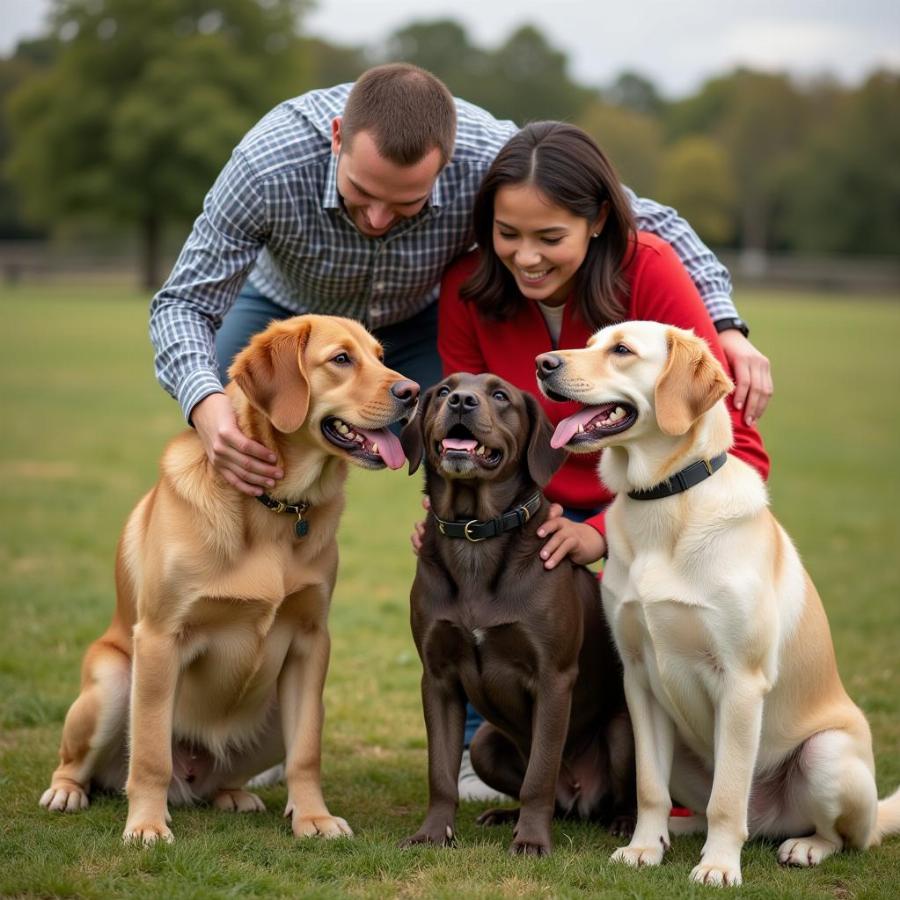Choosing the right dog breed can be a big decision. If you’re considering a powerful and loyal companion, both the Pitbull and American Bulldog might be on your radar. While they share some physical similarities and temperamental traits, understanding the key differences is crucial for making an informed choice. This article will delve into the distinct characteristics of each breed, exploring their history, temperament, physical attributes, exercise needs, and training considerations, ultimately helping you determine which breed, if either, is the right fit for your lifestyle.
History and Origin: Tracing the Lineage
The term “Pitbull” often refers to several breeds, including the American Pit Bull Terrier, American Staffordshire Terrier, and Staffordshire Bull Terrier. These breeds share a common ancestor in the bull-and-terrier dogs of 19th-century England, bred for bull-baiting and other blood sports. The American Bulldog, on the other hand, has a more direct lineage to the Old English Bulldog, brought to the American South by working-class immigrants. These dogs were prized for their farm utility, guarding properties, and catching stray cattle.
Temperament and Personality: Decoding Their Behavior
Both breeds are known for their loyalty and affection towards their families. However, their temperaments exhibit subtle differences. Pitbulls, when properly socialized, can be incredibly loving and gentle with their family members, including children. American Bulldogs, while also affectionate, tend to be more independent and protective, making them excellent guard dogs.
Physical Characteristics: Spotting the Distinctions
While both breeds are muscular and powerful, there are noticeable physical differences. Pitbulls are generally smaller and more agile, with a shorter, smoother coat. American Bulldogs are larger and stockier, with a looser, more wrinkled skin, particularly around the face and neck. They also tend to have a slightly longer coat that can be white, brindle, or a combination of colors.
Exercise and Training: Meeting Their Needs
Both Pitbulls and American Bulldogs require regular exercise to stay healthy and happy. Pitbulls thrive on activities that engage their minds and bodies, such as agility training or playing fetch. American Bulldogs also benefit from vigorous exercise but can be prone to overheating in hot weather due to their shorter snouts. Early socialization and consistent training are essential for both breeds to ensure they develop into well-behaved companions.
Health Concerns: A Proactive Approach
Like all breeds, both Pitbulls and American Bulldogs are susceptible to certain health issues. Pitbulls can be prone to hip dysplasia and skin allergies, while American Bulldogs may experience breathing problems related to their brachycephalic (short-nosed) features. Responsible breeding practices and regular veterinary checkups are crucial for mitigating these risks.
Which Breed is Right for You?: Making the Final Decision
So, Pitbull or American Bulldog? The answer depends on your individual lifestyle and preferences. If you’re an active individual or family seeking a loyal and affectionate companion who thrives on physical and mental stimulation, a Pitbull might be a good fit. If you prioritize a protective and independent dog with a strong guarding instinct, an American Bulldog could be the better choice.
Conclusion: A Well-Informed Choice
Choosing between a Pitbull and an American Bulldog is a significant decision. By understanding their distinct histories, temperaments, physical characteristics, and exercise needs, you can make an informed choice that aligns with your lifestyle and ensures a harmonious relationship with your canine companion. Remember, responsible ownership includes providing proper training, socialization, and healthcare to ensure a happy and healthy life for your dog.
FAQs: Addressing Common Queries
-
Are Pitbulls more aggressive than American Bulldogs? Aggression is not inherent to any breed. Proper socialization and training are key to shaping a dog’s behavior.
-
Do American Bulldogs require a large yard? While a yard is beneficial, regular exercise is more important. They can adapt to apartment living with sufficient daily activity.
-
Are Pitbulls good with children? With proper socialization, Pitbulls can be loving and gentle with children. Supervision is always recommended.
-
What is the lifespan of an American Bulldog? American Bulldogs typically live between 10 and 15 years.
-
Are Pitbulls easy to train? Pitbulls are intelligent and eager to please, making them relatively easy to train with positive reinforcement methods.
-
Do American Bulldogs shed a lot? American Bulldogs shed moderately. Regular brushing can help manage shedding.
-
Are Pitbulls banned in some areas? Breed-specific legislation exists in some areas. It’s important to research local laws before acquiring a Pitbull.
Further Reading and Resources
- [Internal link to article about Pitbull training](Pitbull Training Tips)
- [Internal link to article about American Bulldog grooming](American Bulldog Grooming Guide)
- [Internal link to article about dog adoption](Adopting a Dog: A Complete Guide)
 Pitbull and American Bulldog as Family Companions
Pitbull and American Bulldog as Family Companions
If you need further assistance or have specific questions, please don’t hesitate to contact us at [email protected] for detailed and accurate answers. Beaut Dogs is your go-to resource for reliable, helpful, and in-depth information about the world of dogs. Visit us at https://beautdogs.com today to explore the wonderful world of dog breeds and learn how to care for them! We offer a wealth of knowledge on breed characteristics, temperament, and care requirements, empowering you to make informed decisions about dog ownership.